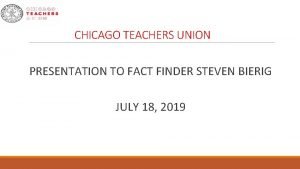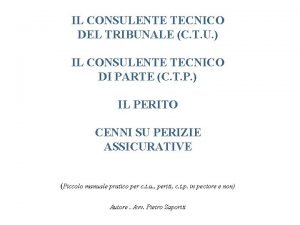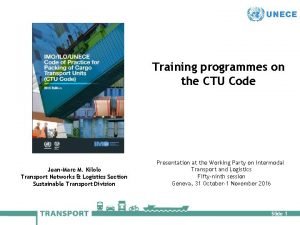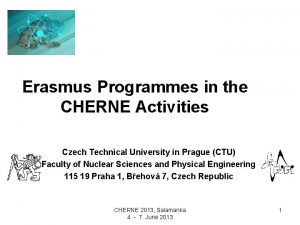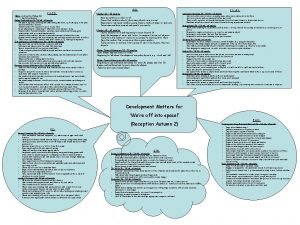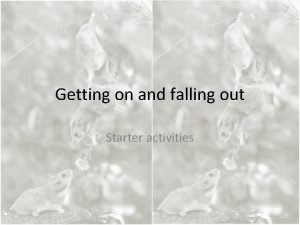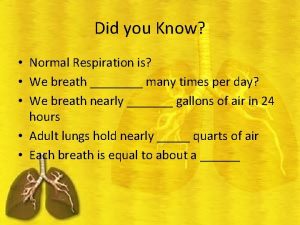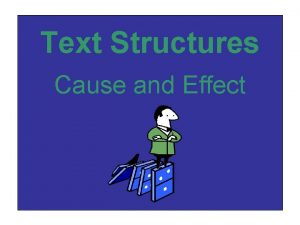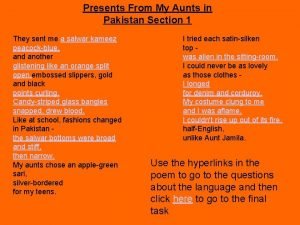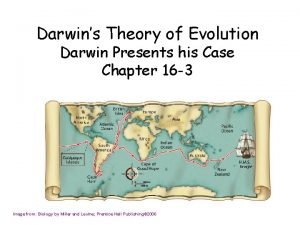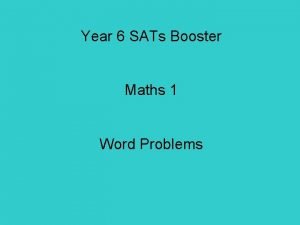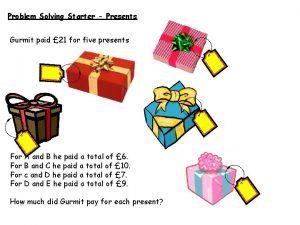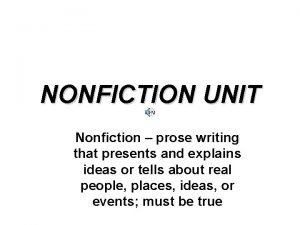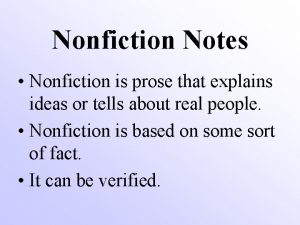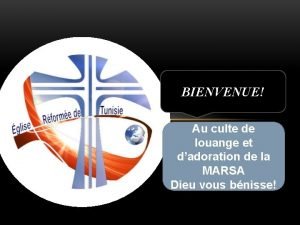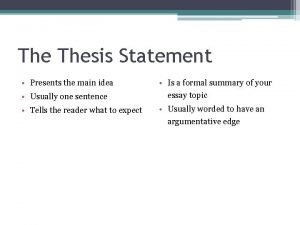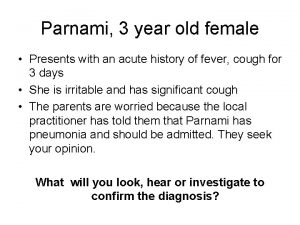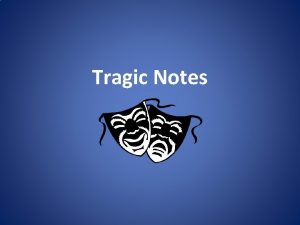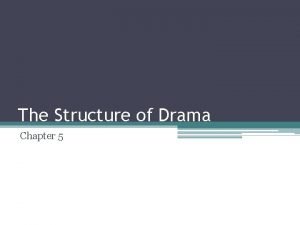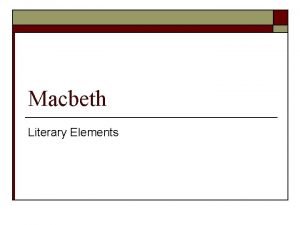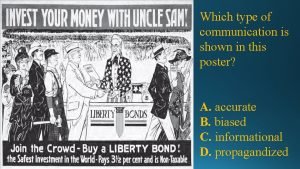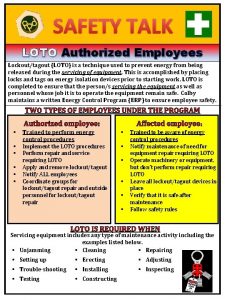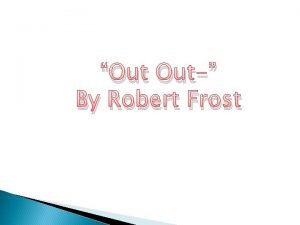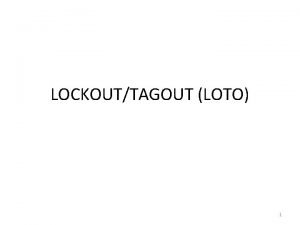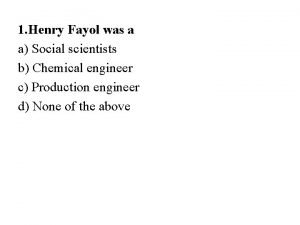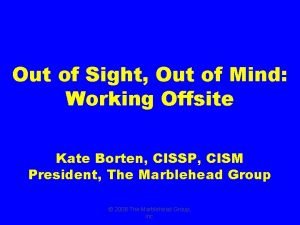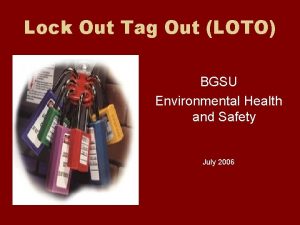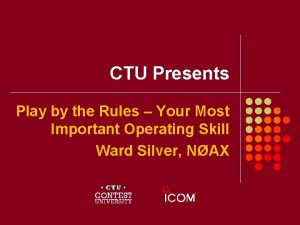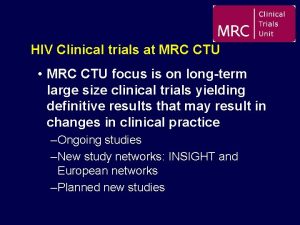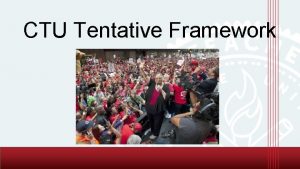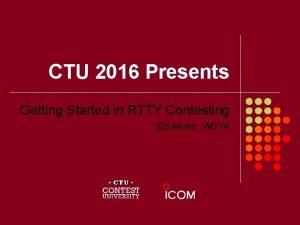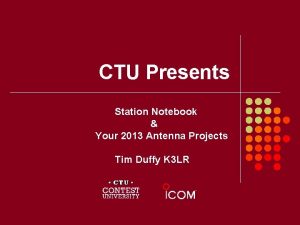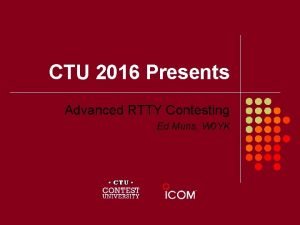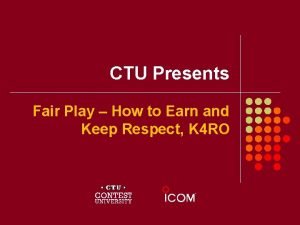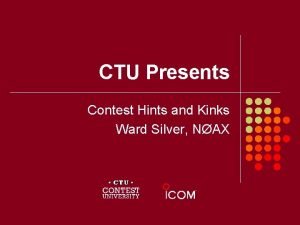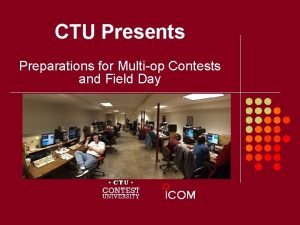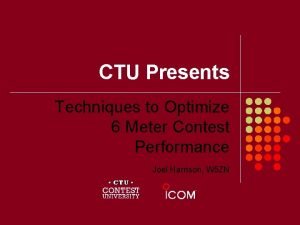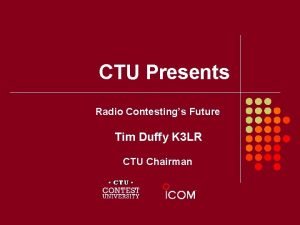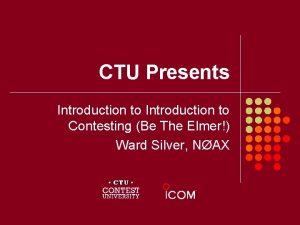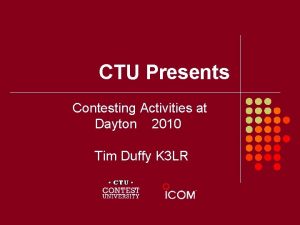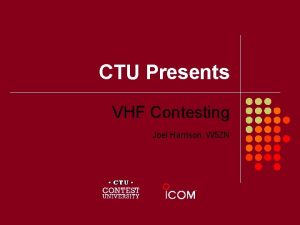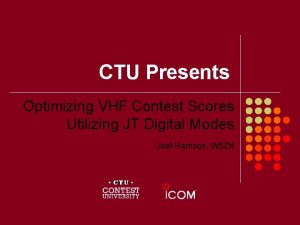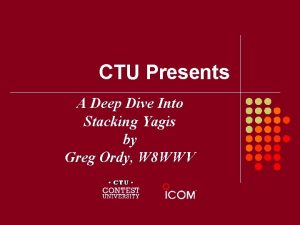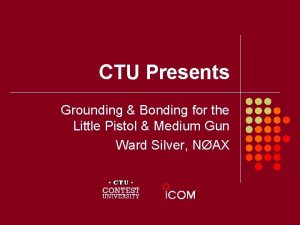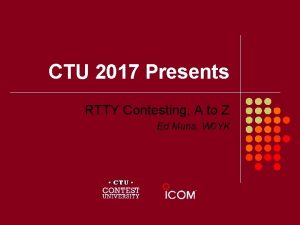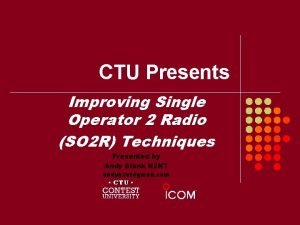CTU Presents Getting the Most Out of Your
































































- Slides: 64

CTU Presents Getting the Most Out of Your VHF Contesting Experience Joel Harrison, W 5 ZN

VHF Contesting – Expectations l Advanages l l l Magic Bands Super Results from Average Stations Great activity to obtain new operating awards Intense excitement when bands open Disadvantage l QSO rates are not normally as continuous as HF on 2 meters & above

What Contests are Available? l ARRL l l CQ l l January June September July Many other smaller events throughout the year

What Contests are Available? l ARRL June VHF Contest l The premier VHF contest of the year l Occurs during peak Sporadic E Season l Excellent weather condx for roving or mountain top operating

What Bands are Important? l 6 Meters l l The major focus – 50. 125 is calling freq Spread out during contest. Stations will be on: l l l Band can open unexpectedly with Es l l 50. 080 - 50. 105 CW (50. 105 - 50. 120 DX Reserved) 50. 125 – 50. 200+ SSB Keep a dedicated radio here or monitor by other means Provides most Q’s and Mult’s

What Bands are Important? l 2 Meters l Second most important l l 144. 200 is center of activity but listen up and down 25 KHz or more in populated areas Es can extend to 2 meters

What Bands are Important? l 432 MHz l Third most important band l l l 432. 100 is center of activity and calling frequency Stations will move 10 to 20 KHz up or down during heavy activity 222 MHz l l Not as populated as other three bands but plenty of activity in populated areas. 222. 100 is activity center

What Bands are Important? l Microwave Bands l l Not as much activity as in previous years Concentrated in populated areas Many rovers have these bands 902. 100 (or 903 in some areas) 1296. 100, 2304. 100, 3456. 100, 5760. 100 & 10368. 100 is center of activity and calling frequency l You normally won’t hear stations calling CQ here but they will move stations here from the lower bands

Categories l Standard l l l Single OP Multi Op Unique l l l Rover Single Op 3 Band (50, 144 and 432 MHz) FM Only

Contest Exchange Grid Squares

Station Basics l 6 Meters l l Radio or transverter is fine 50 watts is great, 100 watt is outstanding 3 element antenna up at least 30 ft is good 2 Meters l l l Radio or transverter is fine >50 watts 13 element beam @ ~50 ft

Station Basics l 222 – 432 MHz l l >50 watts 16 element & 25 element @ ~50 ft Boom length 902 MHz & Up l l >10 watts Loop yagis & parabolic (dish) antennas

Station Basics - Noise The Grim Reaper of noise is not your friend!! - Sky Noise - Atmospheric Noise - Line Noise - Other man-made noise

Station Basics - Noise l Internet Routers can be a significant noise source at 50 MHz that will populate the band, especially the DX Window l Multiple carriers of relatively constant amplitude but with modulation (Birdies) l l l 50. 044, 50. 058, 50. 105, 50. 120, 50. 148, 50. 166 Broadband trash Get your own station “clean” first!

Station Basics - Noise Internet Router noise can be significantly reduced or eliminated. Also utilize shielded CAT 5 cable and connectors

Station Basics - Noise l l Some Actual Results l All “birdies” are gone l Noise floor dropped 8 d. Bm !!! More technical info: l A Ham’s Guide to RFI, Ferrites, Baluns and Audio Interfacing - Jim Brown, K 9 YC l http: //audiosystemsgroup. com

Propagation – What can I Expect l Sporadic E – “Es” l Tropospheric Ducting – “Tropo” l Meteor Scatter – “MS” l Even EME!!!!!

Propagation – Es l Sporadic ionization of the E-Layer l l 50 & 144 MHz, possibly 222 MHz l l l Peaks May–July, Possibly generated by lightning Single-hop optimum range 900 -1300 miles, maximum range 1350 -1500 miles Double-hop optimum range 2000 -2600 miles, maximum range 2750 -3100 miles Peak time during daylight hours & early evening

Propagation – Es

Propagation - Tropo l Natural atmospheric ducts that form due to temperature inversion and can shuffle VHF and UHF radio waves long distances l All bands l Any time, but mostly warm weather months

Propagation - Tropo

Propagation – MS l Meteor scatter is the reflection of radio waves from the ionized trails from meteors burning up in the upper atmosphere. l Meteors burn up in the upper atmosphere at a height of around 65 miles. l This may be used to make QSOs up to about 1400 miles

Propagation – MS Reflection will occur when the trail is oriented as shown

Propagation – MS l Excellent for 50 & 144 MHz, possible at 222 MHz l Very Predictable Paths l l Best times between midnight & approx 9 AM Peak during “showers” – Anytime with high speed procedures like WSJT

Equipment l Antennas l Receive Preamplifiers l Amplifiers

Equipment - Antennas l VHF antennas are small in comparison to HF antennas l Boom lengths can be large, 30’ to 50’, but elements length & diameter is much smaller l Antenna stacking for added gain is much easier at VHF

Equipment - Antennas l l What is the best height for my antenna? l You will always have dead zones and nulls regardless of height l Get your antennas as high as you reasonable can Antenna Rule of Thumb #1 Get your VHF antennas above the tree line

Equipment - Antennas Aiming l Pointing your antenna in right direction is MUCH more critical than on HF l Unless two stations are aimed very close at each other you most likely will fail.

Equipment - Receive Preamps l Preamp may not be needed unless your receiver has a really bad noise figure l What is a “bad” noise figure? ? l l Total system noise figure depends more on antenna & sky temperature – they will dominate & you can’t change them At VHF and above, gain is NOT as important as a low noise figure

Equipment - Receive Preamps l Assume Tant = 3000°K l If RX nf is 20 d. B and you add a preamp with only 12 d. B gain but it’s nf is 2 d. B you will improve your system nf by 10 d. B! l If RX nf is 10 db and you add a preamp with 25 d. B gain but it’s nf is 10 d. B you will improve by 0 d. B and cause other problems.

Equipment - Receive Preamps The Simple Bottom Line on Preamps l Preamp Rule of Thumb #1 l Approx 90% of the entire receive system noise figure is determined by the NF of the first stage after the antenna. Coax loss adds directly to the receiver NF and can determine up to 90% of your entire system NF.

Equipment - Receive Preamps l Preamp Rule of Thumb #2 Every time you cut your system noise figure in half you gain approx 3 d. B in signal to noise ratio until you are limited by sky/antenna noise temperature l Preamp Rule of Thumb #3 Mast mounting a preamp is like bringing the RX front end right up to the top of the tower.

Equipment - Receive Preamps l 50 MHz l Not needed unless your radio is really deaf l l 144 MHz l l Recommended for radios, DEMI xvtrs are FB 222 & 432 MHz l l Most new radios do need a preamp!!!!! STRONGLY recommended 902 & Above l Mandatory!

Equipment - Amplifiers l Before you sink a lot of money into a high power amplifier, learn the real facts about “gain”! l Only needed if you want to enter the high power category l There are no “multiband VHF/UHF amplifiers l Outstanding gain can be achieved by stacking antennas

Contest Strategy l Once you decide what you want to do, you must fully understand what will be required to achieve that objective. l How many points do I need? l How many Q’s? How many grids (multipliers) ? l What equipment do I need. l When are the prime propagation times to particular areas

Contest Strategy l Determine what others are accomplishing l l Evaluate top 10 scores for past 10 years Its not all about making the most QSO’s l Maximize grid multipliers

Contest Strategy How To Maximize Your Score Night time Satellite Photo Reveals Population Density

Contest Strategy Grids Within 500 Mile Radius NE Stns W 5 ZN

Contest Strategy Sporadic E 1000 mi Radius NE Stns W 5 ZN

Contest Strategy How Can “Dead Grids” be Activated? l So you want to be a Rover? l What route should I plan? l How do I know where I am when I get there? l What equipment do I need? l What else should I plan for?

Contest Strategy Rovers l What route should I plan? l 6 meters can open to just about anywhere no matter where you are. l For higher bands you should plan an approx 400 mile radius of other stations. l Use GPS (Smart Phone) to identify your exact location

Contest Strategy Rovers l What route should I plan?

Contest Strategy Rovers l What equipment do I need? l Multi-band VHF radios that cover 50 through 432 MHz are great!! (FT-847, FT-736, TS-2000) l Can interface with transverters a plus! l Transverters for higher bands l Smaller antennas

Contest Strategy Rovers W 5 LUA / WA 8 RJF Rover Antennas 50 – 432 MHz W 5 LUA / WA 8 RJF Rover Equipment 50 – 432 MHz

Contest Strategy Rovers N 2 CEI / K 4 SME Rover Station 50 MHz – 10 GHz

Contest Strategy Rovers 50 MHz – 432 MHz Rovers

Contest Strategy Rovers l What else should I plan for? l Bad weather l K 4 SME/N 2 CEI got in a tornado in 2011 l Vehicle breakdown l Adequate rest over a 36 hour contest period l Emergency Medical Assistance

Contest Strategy K 1 JT Digital Modes l Weak Signal Communication by K 1 JT (WSJT) offers specific digital protocols optimized for EME and meteor scatter at VHF/UHF l Free open-source programs. Normal usage requires only a standard SSB transceiver and a personal computer with soundcard.

Contest Strategy K 1 JT Digital Modes l Can Provide Outstanding access to new grid multipliers from moderate stations l l l FSK 441 for Meteor Scatter JT 65 for EME for Single Yagi stations

Contest Strategy K 1 JT Digital Modes – Meteor Scatter

Contest Strategy K 1 JT Digital Modes – Meteor Scatter l FSK 441 Mode l l Calling frequencies 50. 260 & 144. 140 Single Antenna & 100 W is outstanding Antenna is pointed toward station worked Run 30 second sequences l Normally eastern most station runs 1 st 30 second period (0 -30) and western station runs 2 nd 30 second period (31 -00).

Contest Strategy K 1 JT Digital Modes – Meteor Scatter l FSK 441 Mode (cont) l l l Once calls are received stations start sending report Stations will be on after 0500 z Listen on 50. 260 in “Monitor” mode for stations calling CQ l You may hear “CQ W 5 ZN EM 45 U 5” or “D 10” § § U 5 means the CQ station is listening Up 5 KHz Call there. When CQ station hears you he will begin transmitting Up 5 KHz.

Contest Strategy K 1 JT Digital Modes – Moonbounce (EME)

Contest Strategy K 1 JT Digital Modes – Moonbounce (EME) l JT-65 B Mode l l l 144 MHz and 432 MHz No Calling frequencies Single antenna & 100 W can work big stations l l l More antennas + More power = More Success 2 antennas & 300 – 400 watts is very good Must aim antenna at the moon l If you can’t elevate antennas then catch moon at horizon on “moonrise” or “moonset”

Contest Strategy K 1 JT Digital Modes – Moonbounce (EME) l JT-65 B Mode (Cont) l Run 1 minute sequences l l After calls are sent and received send report l l l Normally eastern most station runs 1 st “even” period (beginning at 0, 2, 4 etc min) and western station runs 2 nd “odd” 1 minute period (1, 3, 5 tec min). Report is “OOO” After report is received send “RO” Complete with “R” and “ 73”

Contest Strategy K 1 JT Digital Modes l Download Free Software at: http: //physics. princeton. edu/pulsar/K 1 JT/wsjt. html Download User’s Guide at: http: //physics. princeton. edu/pulsar/K 1 JT/WSJT_User_600. pdf

Operating Technique l How to monitor for an unpredictable band opening: l l l Radio with Panadapter CW Skimmer ON 4 KST Region 2 - 50 MHz Chat DX Sherlock l Based on Cluster spots & shows paths DX Cluster CAUTION!! Stay within the rules for your operating category when using the above!

Operating Technique l READ THE RULES!!!!!! l l Different contests have different rules. Some allow assistance for single op and some don’t. Do NOT assume they are all the same! The band will not be open continuously or with any certainty l l Monitor & Listen! Monitor & Listen some more!!

Operating Technique l 6 Meters Daylight hours, early evening l ***PRIORITY band when it is open*** l l 144 MHz & Up l Anytime l Sunday Morning – DO NOT MISS l Midnight to 5 AM – DEAD!!! Some Rovers may still be roaming l Meteors & EME with JT Modes l

Operating Technique l 2 Meter FM l FM is NOT a four-letter word l The Q’s count and can add up nicely l Excites the local club and introduces them to contesting l They get to be a part of the big winning team! l Give a presentation at the local club, most new hams have an HT.

Operating Technique l Call CQ in several directions l Keep rotating the antennas every few minutes l Just because you heard nothing in one direction an hour ago doesn’t mean no one is there. A station may now have their antennas your way and listening / CQ’ing l If you hear a weak partial move your antennas

Operating Technique l Keep Track of Grids Not Worked l l Keep track of grids not worked. If you know there are stations there keep going back to that beam heading and listen / call CQ. Move Stations to Other Bands l If you work a station on 2 meters (or 6 meters within range) ask them to move to another band for a quick QSO.

Other Important Points l The Same Principles for HF Apply to VHF l Tower & Electrical Safety l Station Ergonomics l Physical Fitness l ETHICS !!! l A system of moral values and motivation based on right and wrong § “The rules are black and white, we make them gray!” K 5 ZD, CTU Dayton 2009

Where Can I Learn More? l VHF Conferences & Microwave Update l l l Central States VHF Society (CSVHFS) Northeast Weak Signal Society (NEWS) Southeast VHF Society (SEVHFS) Western States Weak Signal Society (WSWSS) Microwave Update Conference l Not “traditional” hamfests l Publish proceedings (compilation of technical papers)
 The secret to getting ahead is getting started
The secret to getting ahead is getting started 3.05 getting the most for your money
3.05 getting the most for your money Czech technical university in prague civil engineering
Czech technical university in prague civil engineering Ctu affidamento figli
Ctu affidamento figli Ctu psrp salary schedule
Ctu psrp salary schedule Ctu open
Ctu open Ctu del tribunale
Ctu del tribunale Ctu code
Ctu code Czech technical university erasmus
Czech technical university erasmus One thing one direction
One thing one direction Seal getting on and falling out
Seal getting on and falling out Getting on and falling out
Getting on and falling out Wind knocked out
Wind knocked out Phrenology
Phrenology You put your left foot in
You put your left foot in The greatest source of ideas for new products is:
The greatest source of ideas for new products is: Give us your hungry your tired your poor
Give us your hungry your tired your poor Cause and effect text structure definition
Cause and effect text structure definition Presents from my aunt in pakistan
Presents from my aunt in pakistan Presents from my aunts in pakistan poem analysis
Presents from my aunts in pakistan poem analysis Business agility metrics
Business agility metrics 16 3 darwin presents his case answer key
16 3 darwin presents his case answer key Section 15-3 darwin presents his case answers
Section 15-3 darwin presents his case answers Sats word problems
Sats word problems Sue palmer skeleton books
Sue palmer skeleton books Zids and zods answers
Zids and zods answers Prose writing that presents and explains ideas
Prose writing that presents and explains ideas What is nonfiction prose
What is nonfiction prose Zids and zods
Zids and zods Where does “snowflake girl” help to deliver presents
Where does “snowflake girl” help to deliver presents Quand je t'ouvre mon coeur je te vois seigneur
Quand je t'ouvre mon coeur je te vois seigneur Which statement presents the main idea of the text?
Which statement presents the main idea of the text? A 26 year old female presents
A 26 year old female presents This presents
This presents What is tragedy
What is tragedy Chapter 5 the structure of drama
Chapter 5 the structure of drama The text presents the house with
The text presents the house with Shcedules
Shcedules Literary elements in macbeth
Literary elements in macbeth Which option presents a clear point of view?
Which option presents a clear point of view? A thesis statement presents
A thesis statement presents Which sentence presents a faulty either/or argument?
Which sentence presents a faulty either/or argument? Chapter 17 neurologic emergencies
Chapter 17 neurologic emergencies Othello put out the light
Othello put out the light Out out by robert frost
Out out by robert frost Out of sight out of mind psychology
Out of sight out of mind psychology Out out robert frost analysis
Out out robert frost analysis Lock out tag out safety talk
Lock out tag out safety talk Robert frost out out
Robert frost out out Lily gulledge
Lily gulledge Matthew 11 msg
Matthew 11 msg Loto
Loto Out, damned spot! out, i say!
Out, damned spot! out, i say! Henri fayol was a social scientist
Henri fayol was a social scientist Makna out of sight out of mind
Makna out of sight out of mind Bgsu quality systems
Bgsu quality systems Hình ảnh bộ gõ cơ thể búng tay
Hình ảnh bộ gõ cơ thể búng tay Lp html
Lp html Bổ thể
Bổ thể Tỉ lệ cơ thể trẻ em
Tỉ lệ cơ thể trẻ em Voi kéo gỗ như thế nào
Voi kéo gỗ như thế nào Thang điểm glasgow
Thang điểm glasgow Chúa yêu trần thế
Chúa yêu trần thế Môn thể thao bắt đầu bằng từ đua
Môn thể thao bắt đầu bằng từ đua Thế nào là hệ số cao nhất
Thế nào là hệ số cao nhất




